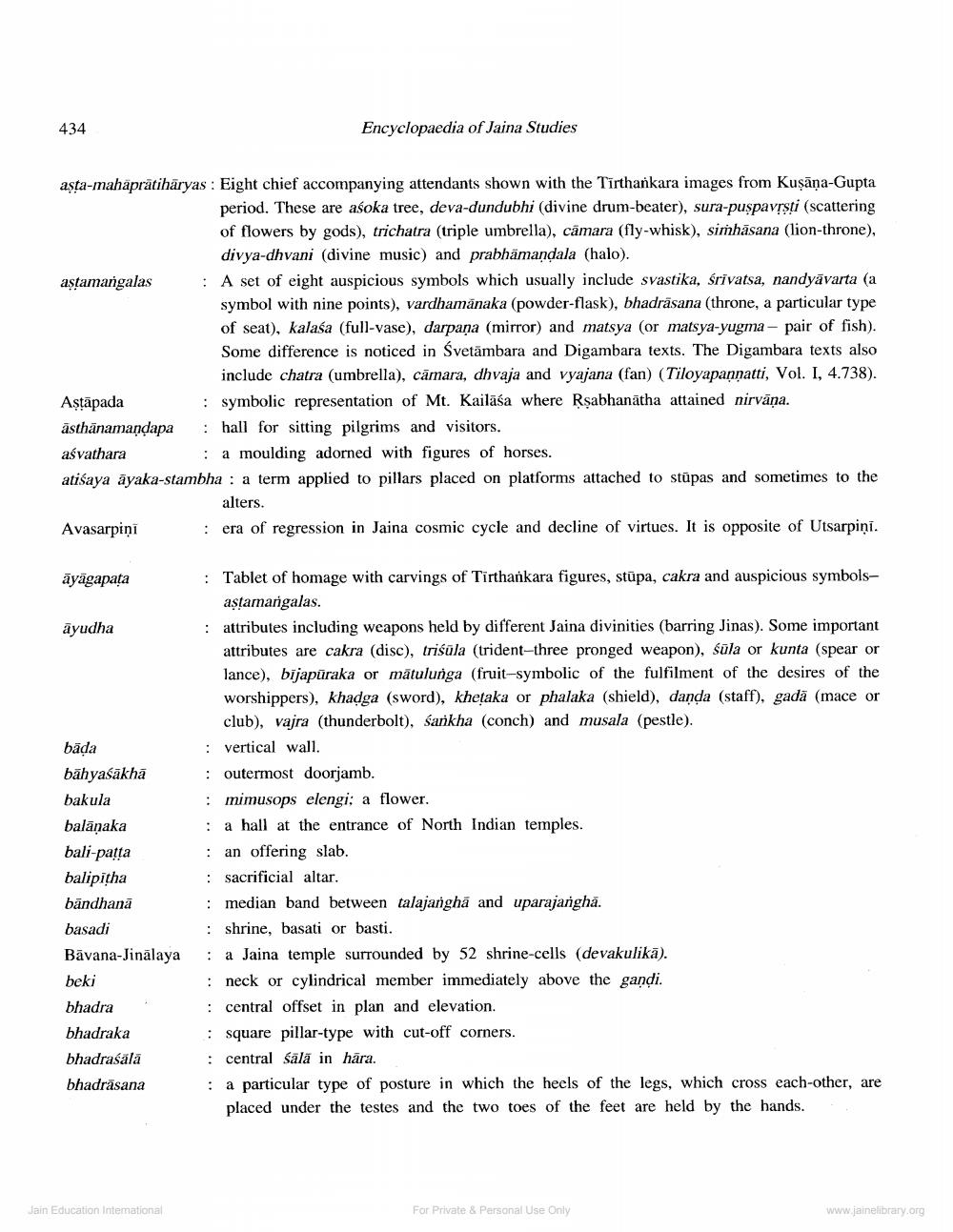________________
434
Encyclopaedia of Jaina Studies
asta-mahäprätiharyas : Eight chief accompanying attendants shown with the Tīrthankara images from Kuşāņa-Gupta
period. These are aśoka tree, deva-dundubhi (divine drum-beater), sura-puşpavrsti (scattering of flowers by gods), trichatra (triple umbrella), câmara (fly-whisk), simhasana (lion-throne),
divya-dhvani (divine music) and prabhamandala (halo). astamangalas : A set of eight auspicious symbols which usually include svastika, srivatsa, nandyāvarta (a
symbol with nine points), vardhamanaka (powder-flask), bhadrâsana (throne, a particular type of seat), kalasa (full-vase), darpana (mirror) and matsya (or matsya-yugma - pair of fish). Some difference is noticed in Svetämbara and Digambara texts. The Digambara texts also
include chatra (umbrella), câmara, dhvaja and vyajana (fan) (Tiloyapannatti, Vol. I, 4.738). Aştāpada
: symbolic representation of Mt. Kailāśa where Rsabhanātha attained nirvana. āsthānamandapa : hall for sitting pilgrims and visitors. aśvathara
: a moulding adorned with figures of horses. atiśaya ayaka-stambha: a term applied to pillars placed on platforms attached to stūpas and sometimes to the
alters. Avasarpiņi
era of regression in Jaina cosmic cycle and decline of virtues. It is opposite of Utsarpiņi.
āyāgapata
ayudha
bāda bāhyaśākha bakula balāņaka bali-patta balipitha bāndhana basadi Bāvana-Jinälaya beki bhadra . bhadraka bhadraśālā bhadrâsana
• Tablet of homage with carvings of Tirthankara figures, stūpa, cakra and auspicious symbols
astamangalas. : attributes including weapons held by different Jaina divinities (barring Jinas). Some important
attributes are cakra (disc), triśüla (trident-three pronged weapon), sula or kunta (spear or lance), bijapūraka or matulunga (fruit-symbolic of the fulfilment of the desires of the worshippers), khadga (sword), khețaka or phalaka (shield), danda (staff), gadā (mace or
club), vajra (thunderbolt), śarikha (conch) and musala (pestle). : vertical wall. : outermost doorjamb. : mimusops elengi: a flower. : a hall at the entrance of North Indian temples. : an offering slab.
sacrificial altar. i median band between talajangha and uparajangha. : shrine, basati or basti. : a Jaina temple surrounded by 52 shrine-cells (devakulikā). : neck or cylindrical member immediately above the gandi. : central offset in plan and elevation. : square pillar-type with cut-off corners. : central śālā in hāra. : a particular type of posture in which the heels of the legs, which cross cach-other, are
placed under the testes and the two toes of the feet are held by the hands.
Jain Education Intemational
For Private & Personal Use Only
For Private & Personal Use Only
www.jainelibrary.org




